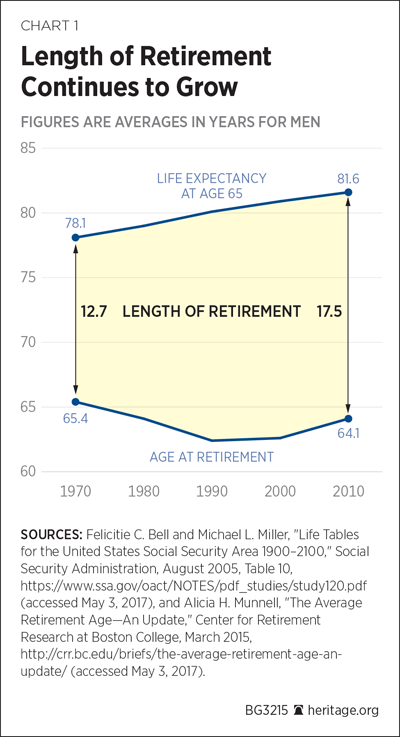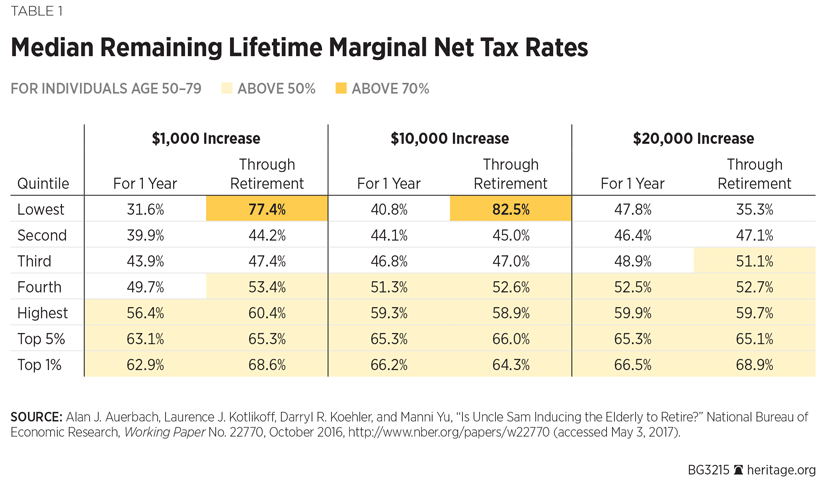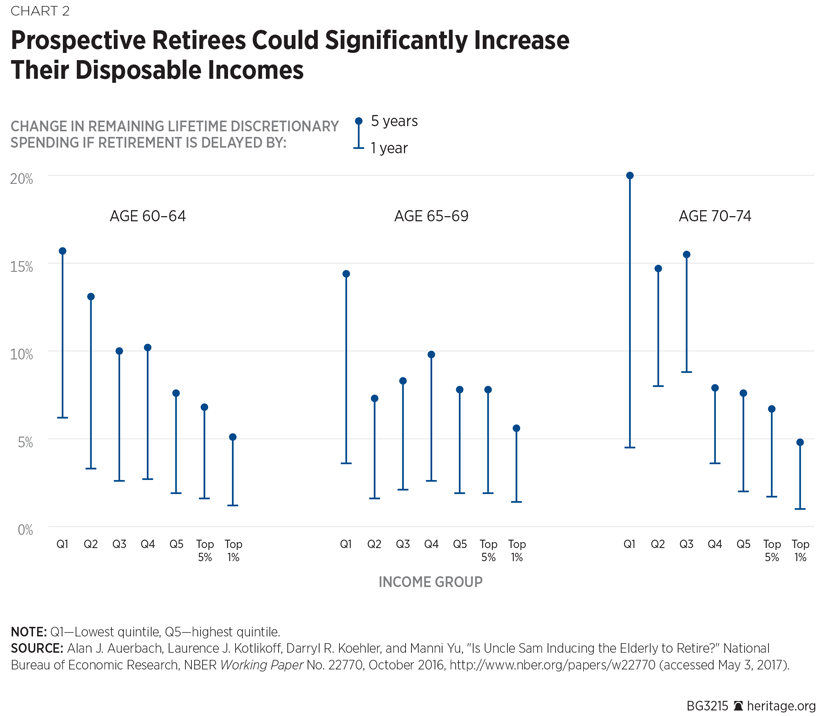Americans are living longer, healthier lives, but they are not working longer as a result. Recent economic studies suggest that many can work longer than they currently do and would be better off economically if they did, but government policies encourage them to retire earlier than they otherwise would. Specifically, the eligibility ages for Social Security and Medicare have not increased with advances in life expectancy and the combination of federal and state taxes, along with changes in government benefits, imposes excessively high marginal tax rates that discourage baby boomers from working longer.
Policymakers should reduce existing penalties in state and federal law that deter longer work lives by:
- Eliminating Social Security’s earnings test,
- Matching Medicare’s eligibility age to Social Security’s and indexing both for life expectancy,
- Eliminating the payroll tax for older workers,
- Allowing workers to receive lump-sum Social Security benefits if they delay claiming them, and
- Implementing work-oriented reforms in government benefit programs.
Longer Lives, Earlier Retirements
Even over the past half-century or so, older Americans have made significant gains in life expectancy. In 1950, the average man retiring at age 65 was expected to live another 13 years and the average woman another 15 years. Today, 65-year-old men are expected to live another 17 years and women another 20 years.[REF]
With improved life expectancies have come improved health and work capacity. A 2016 study by economists at the National Bureau of Economic Research showed that if today’s workers were to keep working as long as workers who had the same mortality rates as they did in 1977, they would work 4.2 years longer.[REF]
Another study by economists David M. Cutler, Ellen Meara, Wilson F. Powell, and Seth Richards-Shubik examined the health and work capacity of older adults and found that health deteriorates very slowly in the 60s and work capacity remains quite large until workers reach their 70s. Based upon the health of today’s young retirees, the authors estimated that employment could be 10 percent to 20 percent greater among older individuals.[REF]
Despite the ability of many Americans to work longer, most are not doing so. In 1950, 45 percent of men ages 65 and older were still working. By 2010, that figure had declined to 22 percent.[REF]
Although recent data show a slight increase in average retirement ages that may or may not continue, government policies are almost certainly contributing to workers retiring earlier than they would otherwise. Workers should be free to retire when they want to, based on what is beneficial for them and their family and in keeping with their health and financial circumstances. The government should not discourage workers from continuing to work as long as they are physically and mentally able to work and desire to continue to work.
Impact of Premature Retirements
When workers retire well before they lose the physical and mental capacity to work, their foregone work translates into lower government revenues, weakened Social Security solvency, potentially lower economic output, and (when coupled with longer life expectancies) higher government benefit costs. Moreover, earlier retirements and foregone work often result in lower standards of living for older Americans.

Lower Government Revenues. When individuals stop working at earlier ages, the government loses tax revenues from their foregone wages and investment income. Although most individuals still pay some taxes on their savings and their benefits during retirement, that income is typically taxed at a much lower rate than wages.
Weakened Social Security Solvency. Social Security’s benefits are designed to be actuarially fair, meaning the typical worker should receive the same lifetime benefits regardless of whether he retires at the earliest age of eligibility (62), his normal retirement age (between 66 and 67), or a delayed age (beyond 67). However, while Social Security benefits are actuarially fair, the taxes are not. Workers who retire from work at age 62 stop paying Social Security taxes years before those who keep working until their normal or delayed retirement ages. Early retirements mean lower Social Security revenues.
Lower Economic Output. The earlier productive workers retire, the less output they produce over their lifetimes. Additionally, because workers tend to consume slightly less during retirement than during their working years and because earlier retirements can mean less savings and lower resources during retirement, consumer spending—the biggest component of economic output—may decline as a result of earlier retirements.[REF] Finally, earlier retirements mean less time accumulating wealth. Forgone wealth means less investment and lower productivity gains. Thus, earlier retirements impede economic output, consumption, and growth.
Higher Government Benefit Costs. If workers delay their retirement by a few years, they may increase their retirement savings and will have fewer years over which they need to spread their savings. Early retirement, on the other hand, can increase the likelihood that low-income Americans outlive their savings and then turn to means-tested federal welfare benefits such as Supplemental Security Income (SSI), food stamps, housing assistance, and Affordable Care Act health insurance subsidies.[REF]
Lower Standard of Living. In a recent study, economists Alan J. Auerbach, Laurence J. Kotlikoff, Darryl R. Koehler, and Manni Yu found that “many, if not most, Baby Boomers appear at risk of suffering a major decline in their living standard in retirement.”[REF] The authors found that working as many as five additional years could significantly raise older workers’ sustainable living standards. However, government policies have created such strong and largely perverse incentives that retirement is no longer a personal choice based on individuals’ and families’ unique situations and preferences. Instead, government policies motivate—sometimes even dictate—personal retirement choices. As indicated by the Auerbach et al. study, individual retirement decisions absent the government policies that sway those decisions would result in higher standards of living for current and future retirees.
Government Policies Discourage Longer Work Lives
While longer working lives would tend to raise the living standards of retirees, increase economic output, and improve the U.S. fiscal outlook, government policies discourage older workers from continuing in their careers. According to Auerbach et al., high net taxes—both implicit and explicit—reduce the tangible benefits of additional work and thus discourage older workers from remaining in the workforce.
To assess the potential impact of individuals working longer, Auerbach et al. examined data from workers ages 50–79 as reported in the Federal Reserve’s 2013 Survey of Consumer Finances. The authors ran the data through the Fiscal Analyzer, which calculates workers’ remaining lifetime marginal net tax rates, including both explicit marginal tax rates and implicit rates that affect their receipt of federal and state transfer benefits. This analyzer includes about 30 major federal and state tax-transfer programs such as the income, payroll, and corporate and estate taxes, as well as income-related transfer programs such as food stamps, Medicaid, Medicare Part B premiums, and probability-weighted survival paths for individuals and couples, based on the likelihood of death at each year of age.[REF]
Taxes Plus Government Benefits Create Excessive Marginal Net Tax Rates
Marginal tax rates represent the portion of a worker’s next dollar of income that he or she does not get to take home due to taxes and other offsets like lost benefits. Thus, if a worker earns $1,000 more but has to pay $300 in taxes and loses $200 in government benefits, he or she ends up with only $500 more in take-home pay—a marginal net tax rate of 50 percent. While marginal tax rates account for direct, or explicit, taxes, marginal net tax rates also include indirect, or implicit, marginal taxes.
Some taxes—the explicit or direct ones—are obvious.
- Federal income taxes, which range from 10 percent to about 43 percent (including phaseouts such as the limit on itemized deductions and the loss of the child tax credit as income rises).
- State income taxes, which typically average 5 percent to 6 percent as well as the 15.3 percent federal payroll tax (half of which comes directly from workers’ paychecks and half from their employers).
- A 50 percent implicit tax on Social Security benefits for older workers who begin drawing Social Security benefits before their normal retirement age (66 in 2017) once they earn over $17,000 per year as their benefits are reduced by $1 for every $2 of earnings over $17,000.[REF]
While those payroll taxes are designed to be returned in an “actuarially fair” manner through higher future benefits (assuming workers live long enough to collect those future benefits), most workers do not realize they will get those taxes back.
Other taxes—implicit ones—are less obvious. Medicare premiums, for example, increase with earnings. Many government-provided benefits are either reduced or lost entirely as individuals earn more money, which they do when they work longer before retiring. Medicaid benefits can be lost if workers earn just one dollar over the qualification limit, and other benefits such as food stamps, SSI, and Disability Insurance (DI) are reduced if workers earn over a certain amount.
Older Workers Face Excessive Marginal Net Tax Rates
A central finding of the analysis by Auerbach et al. was that “older workers typically face high, very high, or remarkably high marginal net taxation on their extra earnings.”[REF] This was attributed to the combination of ordinary income and payroll taxes along with the loss in benefits from certain government-provided welfare and entitlement benefits. The authors considered the impact of older workers’ additional earnings over the entirety of their remaining lifetimes.

Although marginal tax rates vary significantly across income quintiles and depending on the amount and duration of additional earnings, marginal net taxes for older workers (ages 50–79) were all significantly high, ranging from about 32 percent to 83 percent. The lowest income quintile of earners faced both the greatest variance in marginal net tax rates and the highest rate.
- A $1,000 increase in earnings for just one year translated into a 31.6 percent marginal net tax rate.
- A $1,000 increase every year through retirement resulted in a 77.4 percent marginal net tax rate.
- A $10,000 increase every year pushed the marginal net rate for the lowest quintile to 82.5 percent.
- Marginal net tax rates were in the mid-40-percent range for the second income quintile, in the high 40s for the middle quintile, the low 50s for the fourth quintile, the high 50s for the top quintile, and the high 60s for the top 1 percentile.
When the authors looked at $20,000 increases in income for just one year, almost three-quarters of those ages 60–64 faced marginal tax rates over 50 percent. The tax rates for this age group are of particular importance because about 60 percent of workers begin collecting Social Security benefits and, presumably, retiring before their normal retirement age, and another 30 percent begin collecting immediately after reaching their normal retirement age.[REF] The authors found that marginal net tax rates in the 60–64 age group were highest for the lowest-income quintile, with average rates exceeding 80 percent. If some older workers take home less than 20 cents of every dollar in additional income, it is no wonder many retire long before they are physically unable to work.
More Work Could Benefit All Americans
According to the authors’ findings, if workers ages 50–79 were to continue working just one more year, they could raise their sustainable living standards (a measure of discretionary spending per household member) by about 2 percent to 8 percent, depending on their age and income levels. If they were to work for an additional five years, they could increase their sustainable living standards by about 8 percent to 20 percent.
Workers in the 60–64 and 70–74 age ranges and lower-income workers would see the largest gains. For example, the Auerbach et al. study found that a low-income worker ages 60–64 could increase her discretionary spending by 6.2 percent if she worked one year longer and by 15.7 percent if she worked five years longer. Workers ages 60–64 in the highest income quintile could increase their discretionary spending by 1.9 percent for an additional year of work and by 7.6 percent for an additional five years of work. If marginal tax rates were not so high, these gains would be even greater.
Older Americans would not be the only ones to gain from their additional work effort. More work would translate into greater economic output, a higher base of income to generate more income and payroll taxes, and potentially reduced costs for transfer benefits.

How to Remove Barriers to Longer Work Lives
The government should not discourage older workers from remaining in the workforce, but high marginal tax rates impose significant penalties on older Americans who continue working. Policymakers should reduce older workers’ marginal net tax rates through the following measures:
Eliminate the Social Security earnings test. Policymakers should eliminate the Social Security earnings test entirely. At least in theory, it is not supposed to generate any additional tax revenue for the government, and yet it serves as a strong disincentive for workers who are between age 62 and their normal retirement age (66) to keep working.
Harmonize Medicare’s eligibility age with Social Security’s and index both to life expectancy. Workers should not be eligible to receive Medicare a year or two before they are eligible for their full Social Security benefits. The two programs were meant to go hand-in-hand, and they should remain that way. With the normal retirement age now at 66 or higher for most current and future retirees, fewer than 10 percent of workers retire at age 65 when they reach their Medicare eligibility age. Medicare’s eligibility age should be brought in line with Social Security’s normal retirement age, and both should be adjusted for life expectancy over time.
Implement work-oriented benefit reforms. If Americans are capable of work, they should be required to work in order to receive certain welfare benefits such as food stamps. More important, Americans who can work should not receive disability benefits intended exclusively for people who cannot work. The current disability determination process is so skewed that the DI program increasingly functions as an early retirement program, with more than half of all DI beneficiaries between ages 55 and 65, instead of as a lifeline for truly disabled individuals.[REF] The DI program also imposes a 100 percent marginal tax on earnings above about $1,200 per month. A tax on work should be irrelevant for disabled people, but since so many DI recipients are capable of work, the dollar-for-dollar loss in DI benefits does have a negative impact on the amount of work performed. The following steps should be taken to reform the DI program:
- Limit benefits to individuals who are physically or mentally unable to work. This requires changes in the disability determination process so that awards are based on true physical or mental disabilities as opposed to factors such as age and inability to speak English.[REF]
- Include in the continuing disability review process an actual review of disabilities as opposed to check-the-box postcards indicating continued disability.
- Incorporate time-limited benefits based on individuals’ potential for recovery into the enhanced reviews.[REF]
- Implement successful return-to-work assistance programs (including an option for private disability insurance) to help people get back on their feet instead of enabling and encouraging them to remain on the disability rolls for life.[REF]
- Implement a work requirement for able-bodied adults receiving food stamps. Without easy access to substantial government benefits, individuals who are capable of work will be more likely to work.
Eliminate the payroll tax once workers reach their normal Social Security retirement age. Although Social Security benefits are actuarially adjusted to fairly compensate workers who do not begin drawing Social Security benefits until after they reach their normal retirement age, those workers are still subject to the 15.3 percent payroll tax on wages. In most situations, workers do not get anything in the form of higher benefits from those additional taxes. Policymakers should consider eliminating the payroll tax for workers once they reach their normal retirement age. This would eliminate the disincentive for older workers to keep working.
Provide lump-sum payouts for delayed Social Security claiming. Many workers want to start drawing Social Security benefits as soon as possible in part because they want to make sure they get something back from the system they paid into their whole working lives. This makes sense, as individuals do not know how long they will live. Rather than adjust future benefits upwards in an actuarially fair way, policymakers should allow workers who work beyond their normal retirement age to receive their normal Social Security benefit along with a lump-sum delayed retirement benefit.
Although workers who opted for a lump-sum benefit would not receive a boost in their monthly Social Security check as a result of delaying their claim, they would still receive as much as if they retired at their full retirement age. Most important, they could use their lump-sum benefit however they desired—to boost their monthly income, to cover some large one-time purchases or expenses, or to save for the future and potentially pass on to their heirs.
In a 2016 economic study as part of a grant from the Social Security Administration, Raimond Maurer and Olivia S. Mitchell looked at older people’s willingness to delay claiming Social Security benefits and to work longer. They found the following results:
- Half of respondents ages 50–70 would delay claiming benefits by four years (from ages 62–66) in exchange for a lump-sum payment, provided they did not have to keep working.
- Only slightly fewer—46 percent—were willing to delay claiming in exchange for a lump-sum benefit, provided they did have to keep working at least part time.
- Workers required a median payment of $60,400 to persuade them to delay claiming benefits without a work requirement and $66,700 with a work requirement.[REF]
- Based on average Social Security benefits of about $15,800 per year and life expectancy of about 84 (for those who reach age 65), it appears that lump-sum payouts—particularly when coupled with a work requirement—could reduce Social Security’s financial shortfalls.[REF]
Considering that an average worker with a $50,000 per year salary would contribute $6,200 in Social Security taxes for each additional year of work, providing larger lump sums to individuals who keep working (assuming the payroll tax is still in place for older workers) makes fiscal and social sense.
Conclusion
With improved health and rising life expectancies, Americans can work longer than they currently do. Individuals, the economy, and government budgets would be better off if workers delayed their retirements, but government policies strongly discourage workers from doing so. With effective marginal tax rates typically above 40 percent and sometimes exceeding 80 percent for older workers, policymakers should seek to reduce excessive marginal tax rates and eliminate any policies that discourage Americans from working longer. This should include a combination of tax, welfare, and entitlement program changes such as eliminating Social Security’s earnings test, matching Medicare’s eligibility age to Social Security and indexing both for life expectancy, implementing work-oriented benefit reforms, eliminating the Social Security tax beyond workers’ normal retirement ages, and giving workers the option of a lump-sum payout in exchange for delayed Social Security claiming.
—Rachel Greszler is Research Fellow in Economics, Budget, and Entitlements in the Thomas A. Roe Institute for Economic Policy Studies, of the Institute for Economic Freedom, at The Heritage Foundation.

